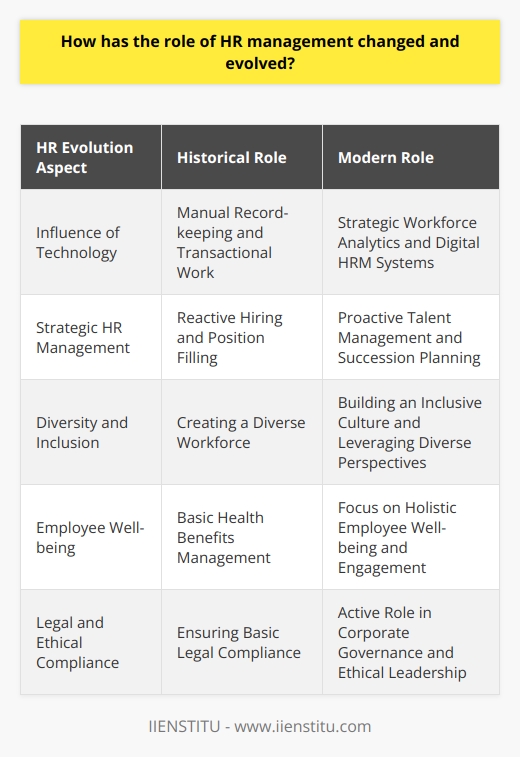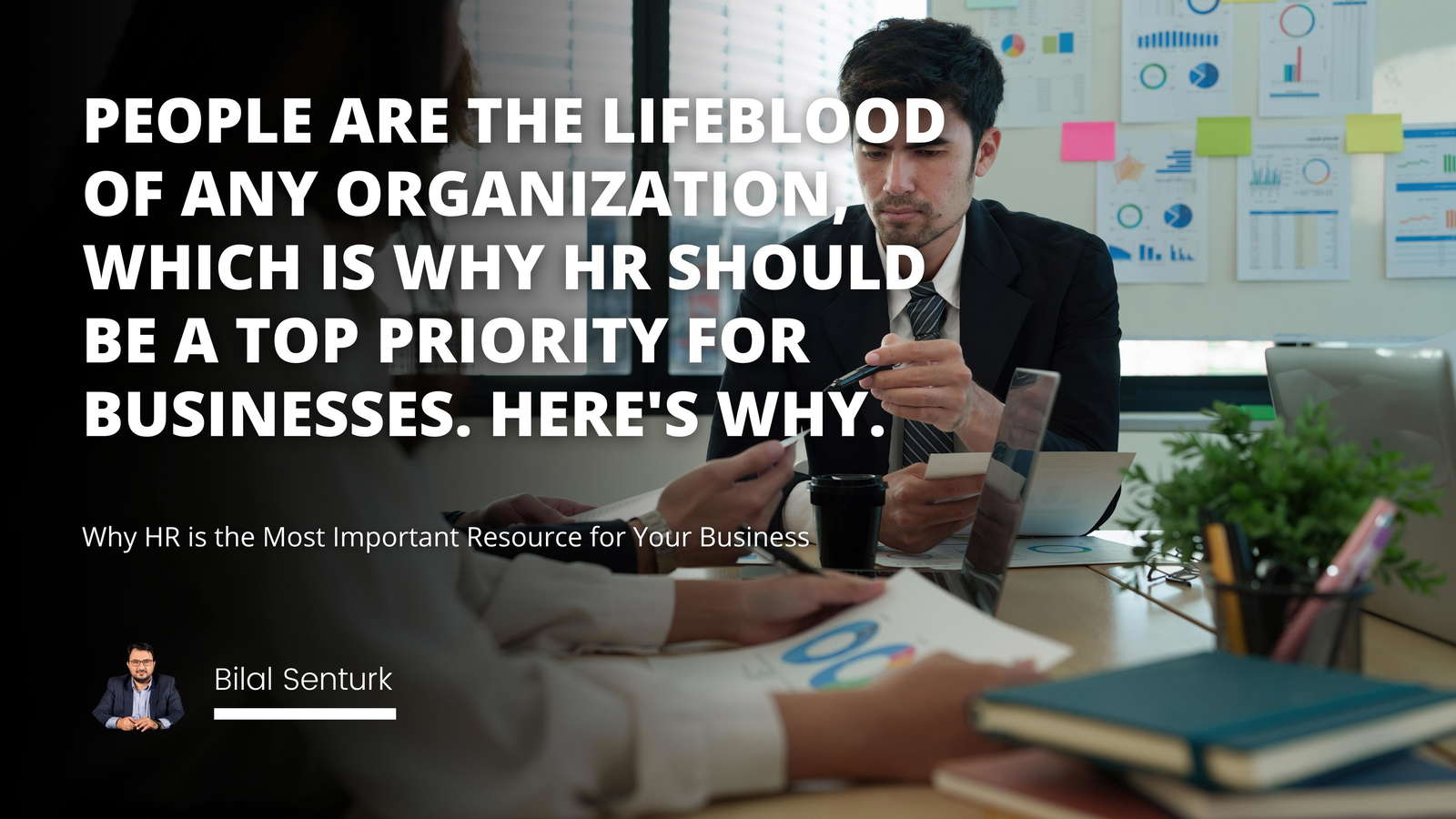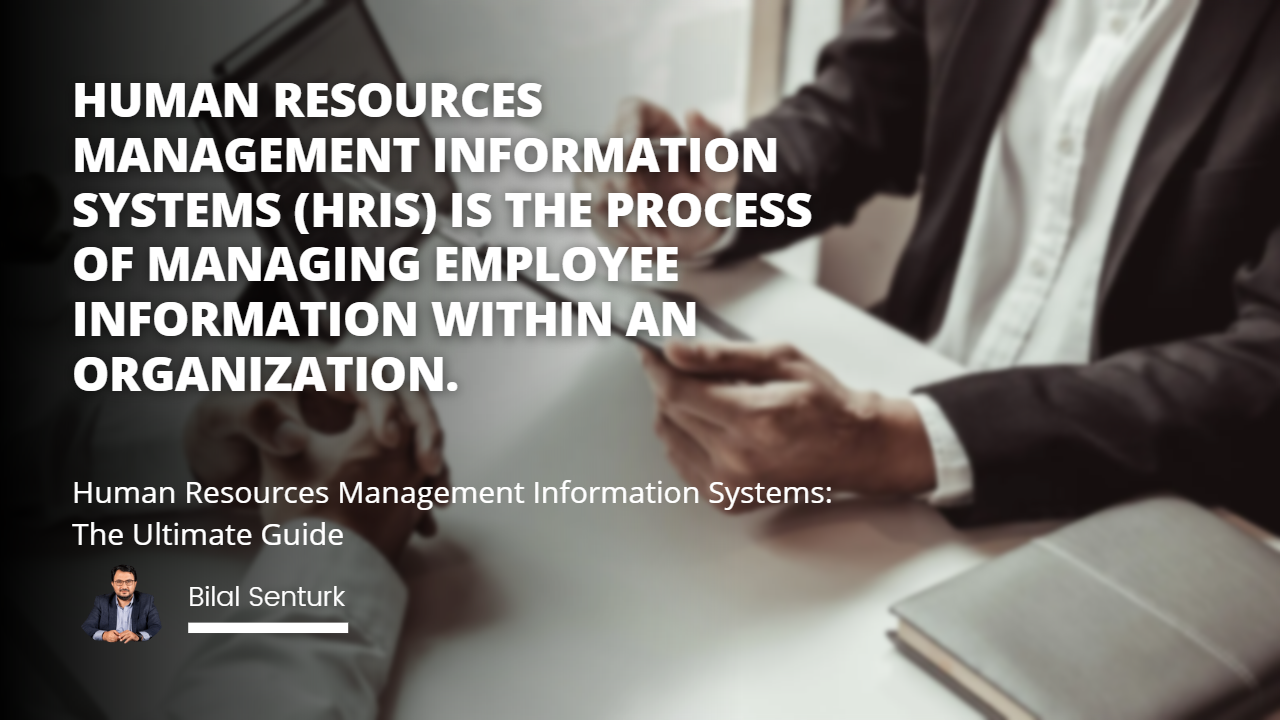
This article discusses the role of Human Resources (HR) practitioners in achieving organizational goals. It explains how they are responsible for developing and implementing strategies to increase productivity and revenue growth and how they help to build organizational capabilities. It also discusses the collaboration between HR and finance and how CFOs perceive HR. The survey of CFOs conducted by CRO Research Services reported that HR and finance work better together than separately and that CFOs recognize the importance of HR in achieving organizational goals. This positions HR practitioners to take on a more strategic role in achieving an organization’s missions and goals.
Introduction
Role of HR Practitioners in Achieving Organizational Goals
Collaboration Between HR and Finance
CFOs’ Perception of HR
Conclusion
Introduction: Human Resources (HR) practitioners are becoming increasingly important in achieving organizational goals. They are developing a better understanding of how to increase revenue growth and productivity and are learning to build organizational capabilities. This is done through collaboration with the financial professionals of an organization. A survey of CFOs conducted by CRO Research Services reported that HR and finance work better together than separately. This article will discuss the role of HR practitioners in achieving organizational goals, the collaboration between HR and finance, and CFOs’ perception of HR.
Role of HR Practitioners in Achieving Organizational Goals
HR practitioners are integral to achieving organizational goals. They are responsible for developing and implementing strategies to increase productivity and revenue growth and help build organizational capabilities. They also manage the recruitment and selection of employees, provide training and development, and ensure compliance with laws and regulations. Additionally, they manage employee relations, develop and implement policies and procedures, and develop compensation and benefits packages.
Collaboration Between HR and Finance
The collaboration between HR and finance has become increasingly important in achieving organizational goals. By working together, HR and finance can develop strategies to increase revenue growth and productivity and provide insights into areas such as cost control, budgeting, and financial analysis. Additionally, working together can develop and implement policies and procedures, manage employee relations, and develop compensation and benefits packages.
CFOs’ Perception of HR
The survey of CFOs conducted by CRO Research Services reported that most respondents view HR as a strategic partner. Thirty-nine percent of respondents said they view HR as “mainly or somewhat as a strategic partner, one-third said they see HR as an even mix of cost center and strategic partner, and 28 percent said they see HR as somewhat or mainly a cost center (HR Magazine, September 2003). This indicates that CFOs recognize the importance of HR in achieving organizational goals.
Conclusion: HR practitioners are increasingly important in achieving organizational goals. They are developing a better understanding of how to increase revenue growth and productivity and are learning to build organizational capabilities. This is done through collaboration with the financial professionals of an organization.
The survey of CFOs conducted by CRO Research Services reported that HR and finance work better together than separately and that CFOs recognize the importance of HR in achieving organizational goals. HR practitioners are positioned to take on a more strategic role in achieving an organization’s missions and goals.
Successful HR management is the key to unlocking a productive and successful workplace.
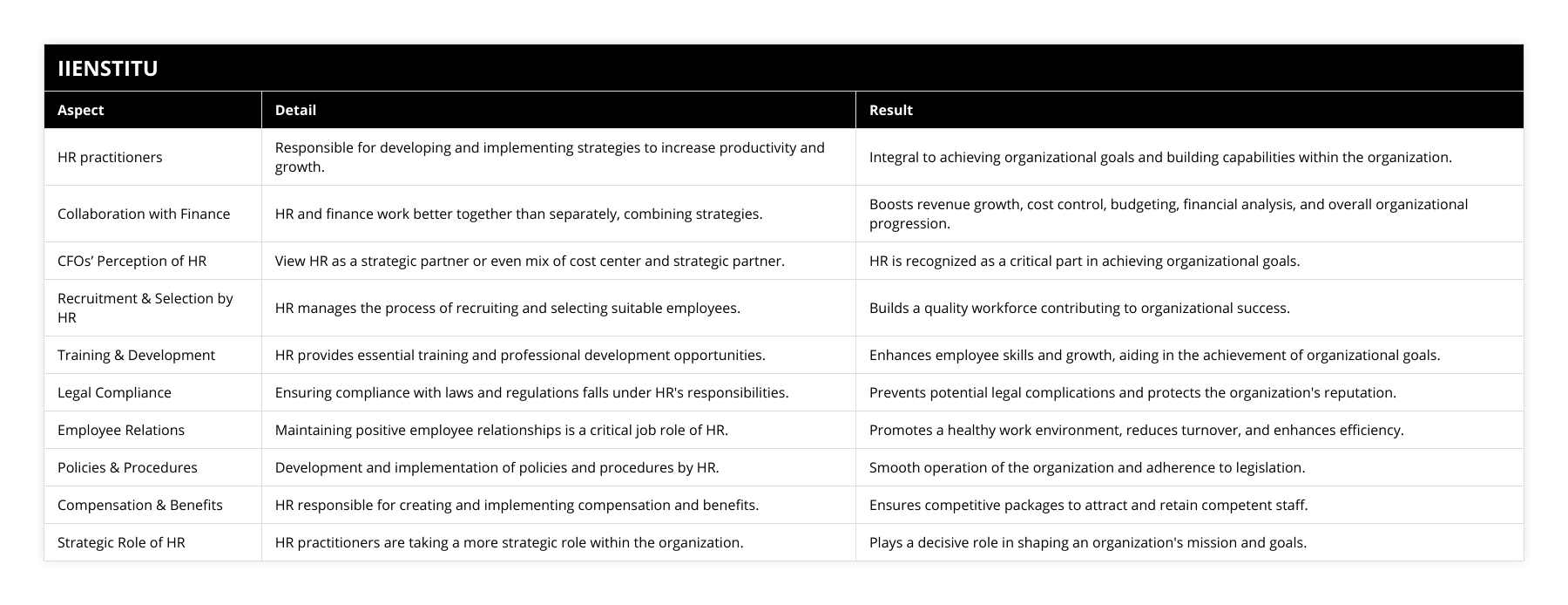
Frequently Asked Questions
What role do HR practitioners play in achieving organizational goals?
Human Resources (HR) practitioners are essential in achieving organizational goals. They are responsible for managing and coordinating an organization's human resources, which is an organization's most critical asset. HR practitioners are tasked with ensuring that the organization's human resources are effectively utilized to meet the organization's strategic goals.
To achieve organizational goals, HR practitioners must understand the organization's strategy, its organizational structure, and the goals it is trying to achieve. Once this is understood, HR practitioners can develop and implement policies and procedures to ensure that the organization’s human resources are managed in line with the organization’s goals. This includes developing recruitment and selection processes, performance management systems, and training and development programs.
HR practitioners also play a key role in managing employee relations. They are responsible for resolving employee conflicts and developing policies and procedures to ensure a harmonious working environment. This is important as it helps to ensure that the organization’s human resources are used effectively and efficiently.
HR practitioners also have a role to play in developing the organization’s culture. They must ensure that the organization’s values and goals are communicated to the employees and adhered to. They must also ensure that the organization’s culture encourages and rewards excellence and innovation.
Finally, HR practitioners must ensure that the organization’s human resources are managed in a way that complies with all relevant laws and regulations. This is important as it helps to protect the organization from legal action and potential fines.
In conclusion, HR practitioners play a vital role in achieving organizational goals. They are responsible for managing and coordinating the organization’s human resources, developing policies and procedures to ensure its goals are met, managing employee relations, and developing its culture. They are also responsible for ensuring that the organization’s human resources are managed in a way that complies with all relevant laws and regulations.
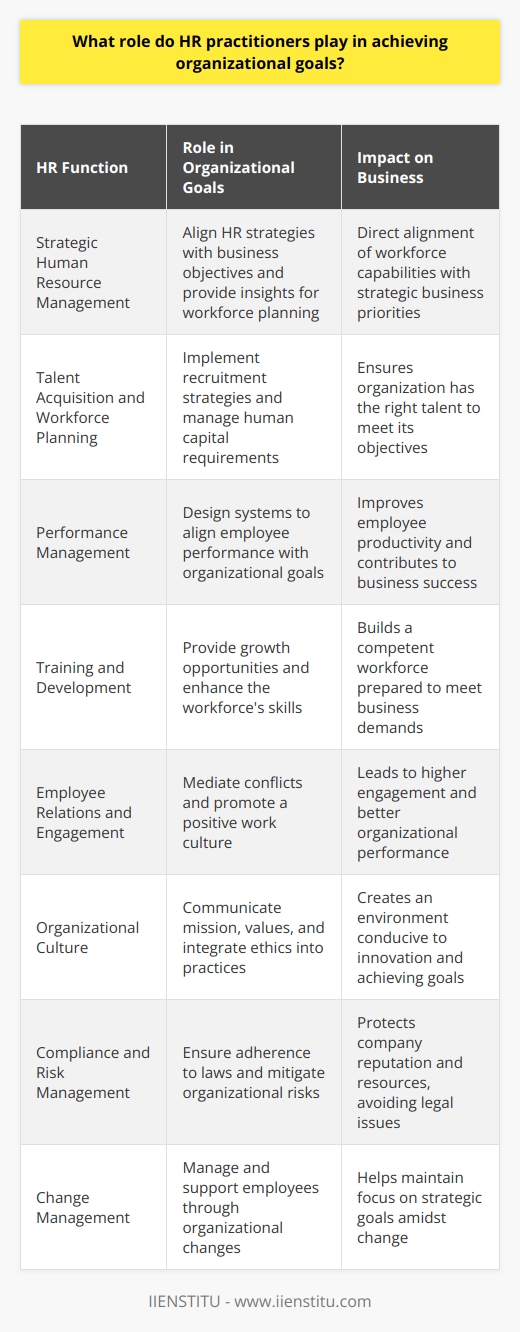
How can HR practitioners collaborate with finance to unlock success?
The role of HR practitioners in the workplace is to ensure that employees are well-equipped to achieve organizational goals and objectives. To do so, HR practitioners must collaborate with other departments in the organization. One such collaboration is between HR and finance. By working together, the two departments can unlock success and increase the overall efficiency of the organization.
The first step in the collaboration between HR and finance is ensuring an understanding of the organization’s financial objectives. This allows the HR practitioner to understand the organization's financial goals and create plans and policies that support these goals. The HR practitioner can then form relationships with the finance team to meet the budget and other financial objectives. This collaboration can also help develop cost-effectiveness strategies and identify opportunities for cost-savings.
The second step is to create a communication system between HR and finance. This system should include regular meetings between the two departments to discuss financial objectives, budgeting, and other topics related to their collaboration. This communication should also include regular updates on the progress of the organization’s financial goals. This allows the finance team to provide feedback and advice to the HR practitioner on improving the organization’s economic performance.
The third step is to develop a system of rewards and incentives that encourages collaboration between HR and finance. This system should incentivize employees to work together to achieve the organization’s financial objectives. For example, HR practitioners can create a reward program that rewards employees for completing tasks that contribute to the organization’s financial goals. This reward and incentive system will help foster collaboration between HR and finance and will encourage employees to work together to achieve the organization’s financial objectives.
In conclusion, a collaboration between HR and finance is essential for the success of any organization. By understanding the organization's financial objectives, creating a system of communication, and developing a system of rewards and incentives, HR practitioners can collaborate with finance to unlock success. By working together, the two departments can ensure that the organization’s financial objectives are met and can achieve its goals.

What is the perception of CFOs towards HR practitioners?
The role of human resources (HR) practitioners within a business organization is often overlooked, yet it is vital for the company's overall success. As the relationship between the HR practitioner and the Chief Financial Officer (CFO) is of utmost importance, it is essential to understand the perception of the CFO towards HR practitioners.
A study by the International Institute of Management in 2019 evaluated the perceptions of CFOs toward HR practitioners. The findings indicated that CFOs view HR practitioners as an essential part of the organization and recognize their contribution to the business's success. CFOs also view HR practitioners as a valuable source of information and insight into the workforce, which can be leveraged to make informed decisions.
The study results also suggest that CFOs have a favorable perception of HR practitioners' skills and abilities, with most CFOs rating HR practitioners as highly competent. CFOs also recognize the importance of HR practitioners in developing and maintaining a productive and engaged workforce. The survey also revealed that CFOs view HR practitioners as professionals who are proactive in solving problems and ensuring that the organization's policies and procedures are followed.
Overall, the survey findings suggest that CFOs positively perceive HR practitioners and recognize their importance to the business's success. By understanding and appreciating the role of HR practitioners, the CFO can foster a collaborative relationship with them, leading to better decision-making and improved performance.
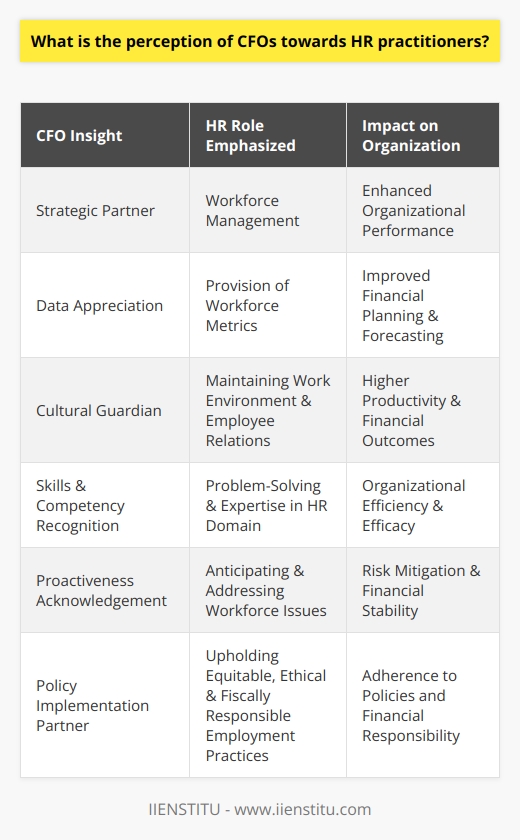
What are the current innovations for HR practitioners?
Current Technological Advancements in HR
Today's human resources practitioners face an ever-changing landscape, with technology playing an increasingly significant role in reshaping traditional HR processes. Among the many current innovations, three key advancements have caught the attention of HR practitioners: artificial intelligence (AI), cloud-based systems, and data-driven decision-making.
Artificial Intelligence in Recruitment and Selection
AI, specifically machine learning algorithms, has revolutionized the way organizations recruit, select, and retain top talent. Through AI-enabled platforms, HR practitioners can now easily sort through large volumes of resumes, assessing candidates based on predefined criteria, and identifying the most fitting applicants, thus enhancing the overall efficiency and accuracy of the recruitment process.
Cloud-based Systems for Streamlined Workflows
Another noteworthy innovation is the rise of cloud-based HR systems. These platforms allow HR practitioners to store, access, and manage employee information in a centralized system, facilitating seamless workflows and real-time communication with employees. Furthermore, cloud-based solutions often provide additional features such as automated HR tasks and report generation, freeing up HR professionals' time to focus on more strategic activities.
Data-driven Decision Making in HR
Lastly, the increasing availability of workforce data has enabled HR practitioners to make more informed decisions based on empirical evidence. By analyzing employee performance metrics, engagement levels, and other relevant data points, HR professionals can identify trends, make better-informed decisions about talent management, and drive organizational success. Leveraging data analytics in HR also helps in identifying skills gaps and forecasting workforce needs, enabling organizations to adapt to dynamic market and industry demands proactively.
In conclusion, current innovations such as AI, cloud-based systems, and data-driven decision-making are not only reshaping traditional HR practices but also enabling HR practitioners to contribute more strategically to their organizations. As the technological landscape continues to evolve, HR professionals must adapt and stay current to thrive in the world of work.

How do I become a successful HR practitioner?
Developing Key Skills and Competencies
To become a successful HR practitioner, it is essential to focus on developing specific key skills and competencies. First and foremost, excellent communication skills are vital, as HR professionals often act as a bridge between employees and management, requiring clear and concise communication in both written and verbal forms.
Understanding the Business Environment
An in-depth understanding of the organization's industry, operations, and goals is necessary for HR practitioners to make informed decisions about employee relations and effective personnel management. This knowledge allows them to create and implement HR policies and programs that align with the organization's objectives and aid its growth and development.
Building Strong Relationships
In the HR field, establishing strong relationships with employees and management is crucial to maintaining organizational harmony and ensuring that conflicts are resolved promptly and effectively. An HR practitioner must be approachable and empathetic, able to listen and understand various perspectives, and provide fair and unbiased feedback and solutions.
Fostering Diversity and Inclusion
A successful HR practitioner must promote diversity and inclusion within the workplace, recognizing the value of different backgrounds, experiences, and perspectives. This involves creating inclusive recruitment and promotion policies and developing programs that encourage collaboration, equity, and equal opportunity for all employees.
Staying Updated on Legal and Regulatory Context
HR professionals must have a strong understanding of legal and regulatory issues affecting the workplace, such as employment law, discrimination, diversity, and labor relations legislation. Keeping up-to-date on these matters ensures compliance with legal requirements and protects the organization from potential legal disputes.
Leveraging Technology and Data-driven Decisions
HR practitioners need to embrace the use of technology in their day-to-day operations, from HR software for administrative tasks to online platforms for employee engagement and training. Additionally, they should rely on data analytics and HR metrics to make informed decisions and recommendations based on objective, quantifiable information.
Engaging in Professional Development
Finally, a fundamental component of becoming a successful HR practitioner is a commitment to continuous learning and professional development. Regularly attending industry conferences, workshops, and webinars, as well as pursuing relevant certifications and advanced degrees, allows HR professionals to stay current on trends and best practices in the field.
In conclusion, by honing essential skills, staying abreast of industry trends and legal updates, embracing technology and data-driven decision-making, and engaging in continuous professional development, aspiring HR practitioners can excel in their roles and contribute significantly to the growth and success of their organizations.

How HR can help managers succeed?
HR Strategies for Managerial Success
One pivotal way Human Resources (HR) can ensure the success of managers is through providing comprehensive recruitment and selection processes. This entails identifying the appropriate candidates with the right skills, knowledge, and cultural fit for managerial roles, giving managers a solid foundation to build success upon.
Developing a talent pipeline
Moreover, HR can nurture and prepare future managers by developing a talent pipeline, which incorporates succession planning, employee assessments, and identifying high-potential individuals. This proactive approach equips organizations with a strong pool of ready-made, internal candidates when managerial positions become vacant, thus promoting continuity and growth.
Effective onboarding programs
HR's role in delivering practical and effective onboarding programs is also crucial in setting up managers for success. By integrating new hires smoothly, HR ensures that new managers receive the necessary resources, training, and support in their initial stages, reducing the likelihood of early turnover and boosting their ability to perform optimally.
Performance management and continuous development
Furthermore, HR plays a vital role in performance management by designing and implementing systems that enable managers to set, track, and evaluate goals. This ongoing process promotes engagement, motivation, and professional development, which in turn contributes to overall managerial success.
Training and development opportunities
In addition, HR can offer tailored training and development opportunities to bolster essential managerial skills, such as communication, leadership, and strategic thinking. By equipping managers with the capabilities required to lead their teams effectively and achieve their objectives, HR aids in enhancing an organization's overall productivity and performance.
Fostering a supportive organizational culture
Lastly, HR's role in fostering a supportive organizational culture cannot be understated. Through promoting collaboration, diversity, and inclusion, HR creates an environment in which managers can thrive. This, coupled with transparent communication channels, enables managers to tackle challenges with a high level of confidence, which ultimately elevates their success.
In conclusion, HR can significantly impact the success of managers through strategic recruitment, talent development, onboarding programs, performance management, training and development opportunities, and fostering a supportive organizational culture. By focusing on these key aspects, organizations can be assured of a high-performing management team poised for long-term growth and success.
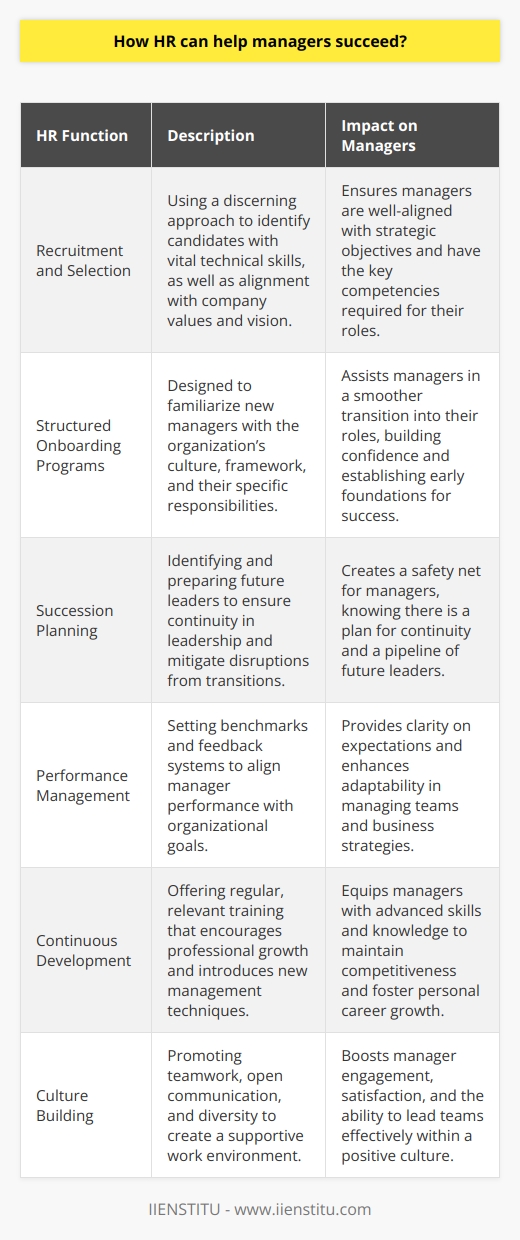
What are the 3 biggest issues in HR today?
Workforce Diversity Management
One of the biggest issues in HR today is managing workforce diversity, as organizations become increasingly global and multicultural. It is critical to create an inclusive work environment where diverse employees can thrive and contribute effectively. HR professionals need to develop and implement strategies that facilitate cross-cultural understanding, mitigate biases, and promote equitable opportunities for all employees.
Digital Transformation and Automation
Another pressing issue in the field of human resource management pertains to digital transformation and automation. The rapid advancements in technology have compelled HR professionals to adapt and evolve their traditional functions. This includes automating administrative tasks, streamlining recruitment and onboarding processes, and leveraging data analytics to make more informed decisions. As a result, HR professionals must adopt a continuous learning mindset and acquire the essential digital skills to stay relevant and effectively manage the changes brought forth by technological innovations.
Employee Mental Health and Well-being
Finally, employee mental health and well-being have surfaced as crucial concerns in HR, particularly in the wake of the COVID-19 pandemic that has disrupted the work landscape. As remote and hybrid work models continue to gain traction, HR professionals must prioritize fostering a supportive company culture that prioritizes employees' physical and psychological health. This can be achieved through implementing effective mental health programs, providing flexibility and support for work-life balance, and promoting open communication and empathy among team members. Addressing these vital issues will enable human resource professionals to maintain a productive, engaged, and resilient workforce in today's dynamic world.
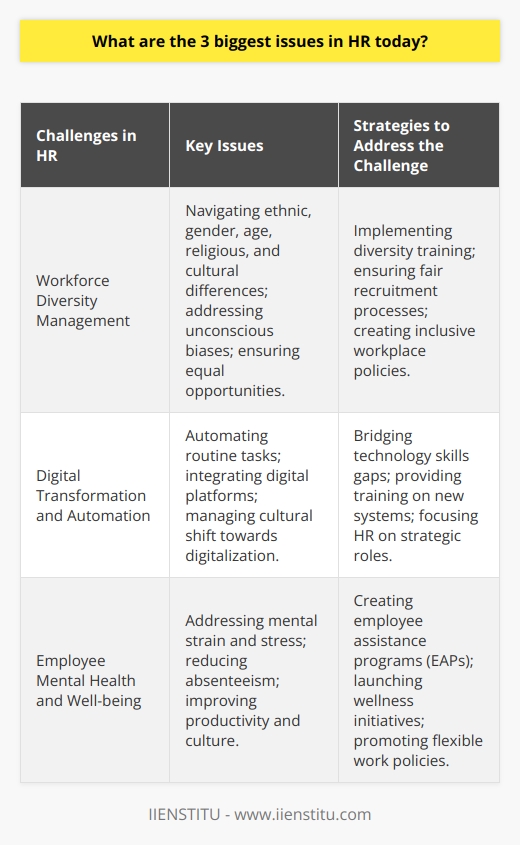
How can HR practitioners effectively address diversity and inclusion in the workplace?
Understanding the Importance of Diversity and Inclusion
To effectively address diversity and inclusion in the workplace, HR practitioners must first gain a comprehensive understanding of their organization's culture and demographics. This involves conducting regular assessments, reviewing company policies, and evaluating recruitment practices. By fostering an inclusive environment, employees from diverse backgrounds will feel valued and respected, leading to enhanced productivity and innovation.
Implementing Inclusive Recruitment Practices
Inclusive recruitment practices are key to promoting diversity in the workplace. HR practitioners should use various channels to widen the candidate pool and reach out to underrepresented communities. Besides, by adopting unbiased interview and selection processes, they can reduce the impact of unconscious bias, ensuring that all candidates have an equal opportunity to excel, irrespective of their backgrounds.
Providing Adequate Training and Development
HR practitioners need to provide ongoing training and development opportunities to all employees to effectively address diversity and inclusion. This includes diversity and inclusion workshops, unconscious bias training, and cross-cultural communication seminars. By educating employees on the benefits of diverse perspectives, HR practitioners can foster an environment of respect, understanding, and collaboration among team members.
Facilitating Employee Resource Groups
Employee resource groups (ERGs) offer an essential support system for employees from various backgrounds. HR practitioners should encourage and facilitate the establishment of ERGs, which promote networking, mentoring, and exchange of ideas. These groups foster a sense of belonging, ultimately creating an inclusive work environment where employees can share their experiences and learn from one another.
Establishing Equity and Inclusivity Metrics
Incorporating equity and inclusivity metrics into performance management systems helps HR practitioners to monitor and evaluate their organization's commitment to diversity and inclusion. These metrics may include employee retention rates, the diversity of the applicant pool, and the success rates of underrepresented groups in leadership roles. By tracking the progress, HR practitioners can identify areas that require improvement and implement targeted strategies to enhance workplace diversity.
Promoting Open Communication and Feedback
Finally, HR practitioners should promote open communication and feedback to make continuous improvements in their organization's diversity and inclusion initiatives. By establishing open channels of communication, employees can express their concerns and share their experiences. Furthermore, regular surveys and feedback mechanisms allow HR practitioners to gauge employee satisfaction and better understand how to support inclusivity in the workplace.
In conclusion, HR practitioners can effectively create an inclusive work environment by understanding the importance of diversity, implementing inclusive recruitment practices, providing adequate training and development, facilitating employee resource groups, establishing equity metrics, and promoting open communication and feedback. These strategies contribute to a diverse and inclusive workplace that encourages employee engagement, satisfaction, and growth.
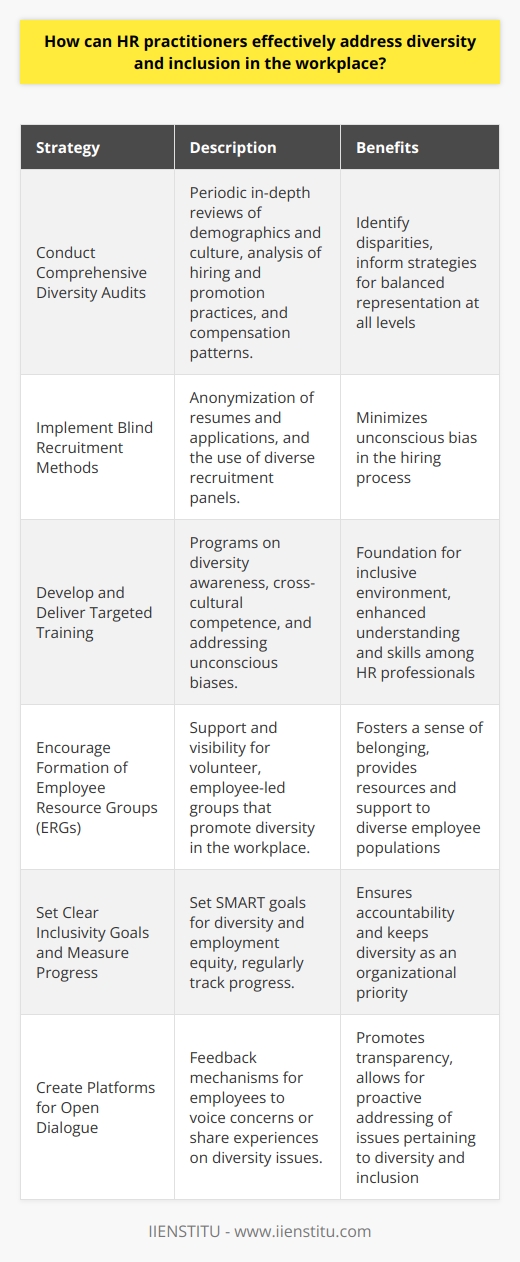
In what ways can HR practitioners leverage technology to improve employee engagement and productivity?
Utilizing Digital Communication Tools
HR practitioners can leverage technology to improve employee engagement and productivity in various ways, including utilizing digital communication tools. Implementing platforms like Slack, Microsoft Teams, or Google Workspace can foster a collaborative work environment, enabling employees to easily share ideas, feedback, and updates on project progress. This ongoing communication can lead to more efficient teamwork, which ultimately improves overall productivity.
Implementing eLearning Programs
Another way HR practitioners can enhance employee engagement and productivity is by providing access to eLearning platforms like Coursera, Udemy, or LinkedIn Learning. These programs allow employees to learn new skills and develop existing ones, empowering them to excel in their roles. Additionally, offering personalized learning paths can enhance engagement as employees feel supported in their professional growth.
Promoting Flexible Work Schedules
HR professionals can also harness technology to promote flexible work schedules, such as remote work, flextime, or compressed workweeks. Tools like project management software (e.g., Asana, Trello) or time-tracking software (e.g., Toggl) can help ensure employees remain accountable and productive, regardless of their location or work schedule. Work flexibility has been proven to contribute to higher levels of job satisfaction and thus may improve overall company performance.
Optimizing Employee Feedback Systems
Technology can aid HR practitioners in optimizing employee feedback systems, such as through the use of online surveys, pulse-checks, or tailored feedback platforms like 15Five. Receiving regular feedback can help employees understand their strengths and weaknesses better, learn where to improve, and stay engaged in their work. Combining the feedback with appropriate recognition programs can motivate employees to work harder and more efficiently.
Utilizing Data Analytics for Decision-Making
Data analytics can provide HR professionals with insights into employee engagement and productivity trends. Using analytics tools and human resources management systems (HRMS), HR practitioners can track various data points such as time allocation, work performance metrics, or employee well-being indicators. This data-driven approach can help establish targeted initiatives to improve engagement and productivity, ensuring that employees receive tailored support based on their specific needs and strengths.
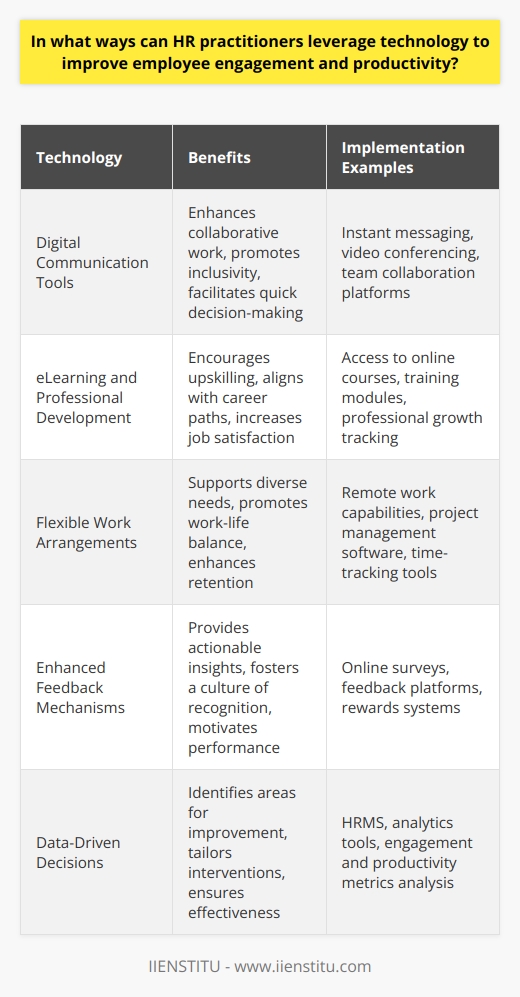
How can HR practitioners foster a positive organizational culture?
Fostering a Positive Culture
One key approach for HR practitioners to foster a positive organizational culture involves establishing clear communication channels. Effective communication allows employees to understand and support the company's goals, and helps create a more engaged workforce. HR professionals can create platforms for open dialogue, actively listen to employee feedback, and ensure that important updates and information are promptly shared.
Emphasizing Professional Growth
Another essential factor in cultivating a positive culture is promoting employee development. HR practitioners can achieve this by creating learning opportunities, such as training sessions, workshops, and mentorship programs. By investing in their employees' growth, organizations demonstrate their commitment to fostering an environment in which individuals can thrive and contribute to the long-term success of the company.
Recognizing Employee Achievements
Moreover, acknowledging and rewarding employee accomplishments plays a significant role in promoting a positive organizational culture. HR practitioners should develop recognition and incentive programs that showcase individual and team accomplishments. By appreciating employees' efforts, HR professionals can encourage a more motivated and engaged workforce.
Embracing Diversity and Inclusion
A crucial component of a positive culture is fostering an inclusive and diverse environment. HR practitioners should develop policies that promote equal opportunities and emphasize the value of different perspectives. By doing so, they can create a sense of belonging and unity in the organization.
Encouraging Work-Life Balance
Finally, HR professionals can contribute to a positive organizational culture by encouraging work-life balance. This can include promoting flexible working arrangements, offering wellness initiatives, and providing support for employees' mental health. An emphasis on work-life balance can reduce stress and burnout, resulting in improved employee satisfaction and increased productivity.
Overall, HR practitioners can foster a positive organizational culture through strategies that prioritize open communication, professional growth, recognition, diversity and inclusion, and work-life balance. By addressing these critical aspects, HR professionals can ensure their organization is viewed as an attractive and desirable place to work, ultimately benefiting both employees and the company's success.
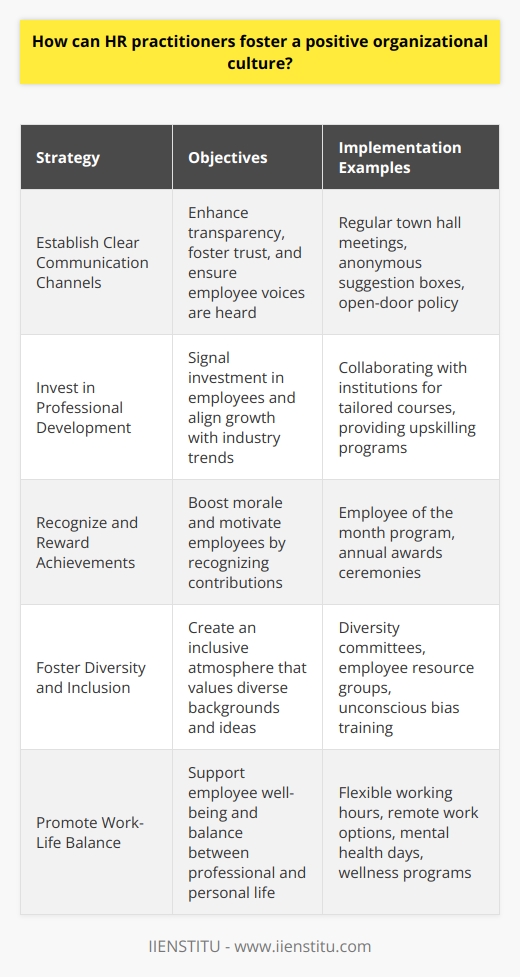
What strategies can be employed by HR practitioners to ensure smooth organizational change?
Effective Communication and Transparency
One crucial strategy that HR practitioners can adopt to facilitate smooth organizational change is to develop and implement effective communication practices. By regularly updating employees on the objectives, progress, and outcomes of the change initiatives, HR practitioners can foster a sense of involvement and ownership among staff members. This open communication approach helps mitigate uncertainty and resistance while encouraging employees to contribute actively to the transformation process.
Employee Involvement and Participation
Another strategy to ensure seamless organizational change is to actively involve and engage employees at various levels of the organization. HR practitioners can achieve this by soliciting employee input during the planning stages, conducting workshops and focus groups, and promoting cross-functional collaboration. This participative approach fosters a sense of commitment and buy-in among the workforce and leads to increased acceptance of the change initiatives.
Training and Development Programs
Investing in employee training and development is essential for successfully implementing organizational change. HR practitioners can design and deliver tailored programs that focus on equipping employees with the necessary skills and competencies required for the revamped organizational processes. By providing adequate training support, HR practitioners can enhance employees' adaptability and ease the transition into the new organizational structure.
Leadership Support and Role Modeling
HR practitioners can also leverage executive support to drive seamless organizational change. By gaining top management's commitment, visible advocacy, and active participation in the change process, HR practitioners can reinforce the importance and urgency of the transformation. When senior leaders exemplify the desired behaviors and attitudes, employees are more likely to embrace the change initiatives and align their actions accordingly.
Monitoring, Evaluation, and Feedback
Lastly, it is critical for HR practitioners to establish monitoring and evaluation mechanisms to track the progress and effectiveness of change initiatives. By constantly reviewing and analyzing organizational data, HR practitioners can identify areas requiring improvement or adaptation, and modify strategies and tactics accordingly. Additionally, promoting a feedback culture among employees enables HR practitioners to gather valuable insights on the perceived success of the change efforts and fine-tune their approaches for maximum impact.
In conclusion, HR practitioners can employ a combination of strategies, including effective communication, employee involvement, training and development initiatives, leadership support, and continuous monitoring and feedback, to ensure the smooth implementation of organizational change. By adopting these tactics, HR practitioners can facilitate a successful transition and foster a positive and adaptive organizational culture.
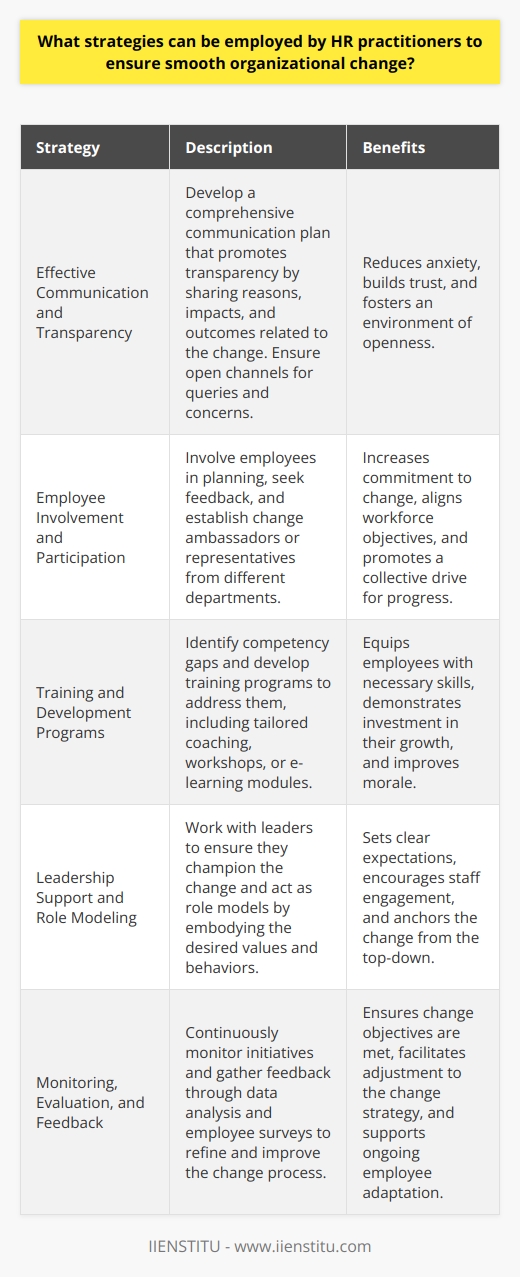
How can HR practitioners be effective strategic partners for an organization's growth and success?
Role of HR Practitioners as Strategic Partners
To enable an organization's growth and success, HR practitioners must serve as effective strategic partners. They can do this by developing a deep understanding of the organization's strategic goals and aligning HR processes and systems accordingly.
Talent Acquisition and Retention Strategies
HR practitioners play a crucial role in attracting, developing, and retaining the right talent. To facilitate this process, they need to implement efficient talent acquisition strategies that align with the organization's long-term objectives. This includes identifying essential job roles and developing a strong employer brand to attract top candidates.
Performance and Employee Engagement
Effective HR practitioners focus on performance and employee engagement as important tools for driving organizational success. By implementing systems for continuous evaluation of employee performance, HR can identify areas of improvement and create opportunities for growth. Additionally, employee engagement initiatives can enhance job satisfaction and lead to higher levels of loyalty and commitment, which drive long-term success.
Leadership Development and Succession Planning
One essential aspect of strategic human resource management is building a robust leadership pipeline. HR teams need to identify and develop high-potential employees, ensuring that they are ready to take on critical leadership positions when required. Succession planning not only promotes smooth transitions within the organization but also helps in retaining top-performing employees.
Upskilling and Reskilling Initiatives
In today's rapidly changing business landscape, HR practitioners need to support organizational growth by promoting a culture of continuous learning. This can be achieved by developing and implementing upskilling and reskilling initiatives. By continually investing in employee development, HR can help close skill gaps that may hinder the organization's growth.
Embracing HR Analytics
The use of HR analytics has emerged as a powerful tool in strategic human resource management. By leveraging data-driven insights, HR practitioners can make informed decisions regarding talent management, workforce planning, and employee engagement. This objective approach to decision-making supports the organization's growth by aligning HR policies and practices with actual performance results.
In conclusion, HR practitioners must play a proactive role as strategic partners by aligning their processes with organizational goals, acquiring and retaining top talent, fostering employee engagement, developing leadership pipelines, promoting continuous learning, and leveraging HR analytics. Adopting these practices, HR practitioners will contribute significantly to an organization's growth and success.
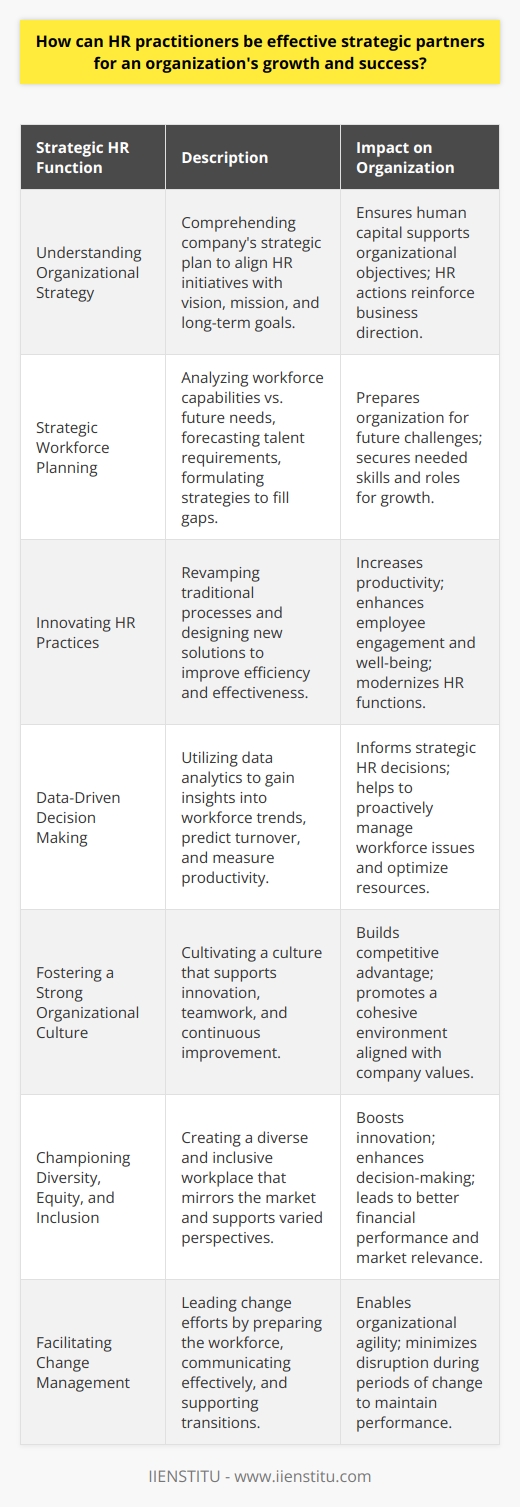
What is the role of HR professionals in performance management?
Role definition and scope of HR professionals
Human Resource (HR) professionals play a critical role in performance management, aiding organizations in realizing their strategic goals through effective employee participation and commitment. As key stakeholders, HR professionals design and implement performance management systems that support the overall organizational strategy, ensuring alignment with business objectives and promoting a high-performance culture.
Development of performance metrics and standards
An essential aspect of performance management is the establishment of clear performance metrics and standards for employees. HR professionals are responsible for identifying and developing these criteria in collaboration with line managers. By aligning employee performance expectations with organizational goals, HR professionals help create a performance-focused work environment that drives productivity and continuous improvement.
Training and development for optimal performance
To ensure employees meet established performance metrics, HR professionals coordinate and facilitate training and development programs aimed at enhancing employees' skills and competencies. Comprehensive training prepares the workforce to adapt to changes in the business environment, including new technologies and evolving market demands. Consequently, HR professionals contribute to organizational success by fostering an agile and skilled workforce capable of meeting performance expectations.
Monitoring and feedback mechanisms
Effective performance management hinges on regular monitoring of employee performance and constructive feedback. HR professionals establish clear feedback mechanisms that facilitate continuous performance appraisal through self-assessment, supervisor evaluations, and 360-degree feedback systems. This comprehensive feedback system enables managers and employees to understand areas of strength and areas in which improvement is needed, leading to targeted interventions that promote growth and development.
Recognizing and rewarding accomplishments
HR professionals also play a significant role in designing and implementing employee recognition and reward systems that motivate employees to perform at their best. By offering compelling incentives, they ensure that high-performance individuals are appropriately rewarded, leading to increased motivation and organizational commitment.
Handling underperformance and succession planning
An essential aspect of performance management is addressing performance issues and conducting succession planning. HR professionals must be skilled in effectively managing underperformance through performance improvement plans or, in some cases, termination of employment. Additionally, they must develop robust succession planning processes to ensure a steady supply of qualified individuals ready to step into key leadership roles, providing organizational stability and sustained performance.
In conclusion, HR professionals perform a vital function in performance management by developing and implementing systems that optimize organizational effectiveness through a well-trained, motivated, and high-performing workforce. Their strategic interventions, including the development of performance metrics, training programs, feedback mechanisms, recognition schemes, and succession planning, ensure that organizations are well-equipped to achieve their business goals and maintain their competitive edge in a dynamic marketplace.
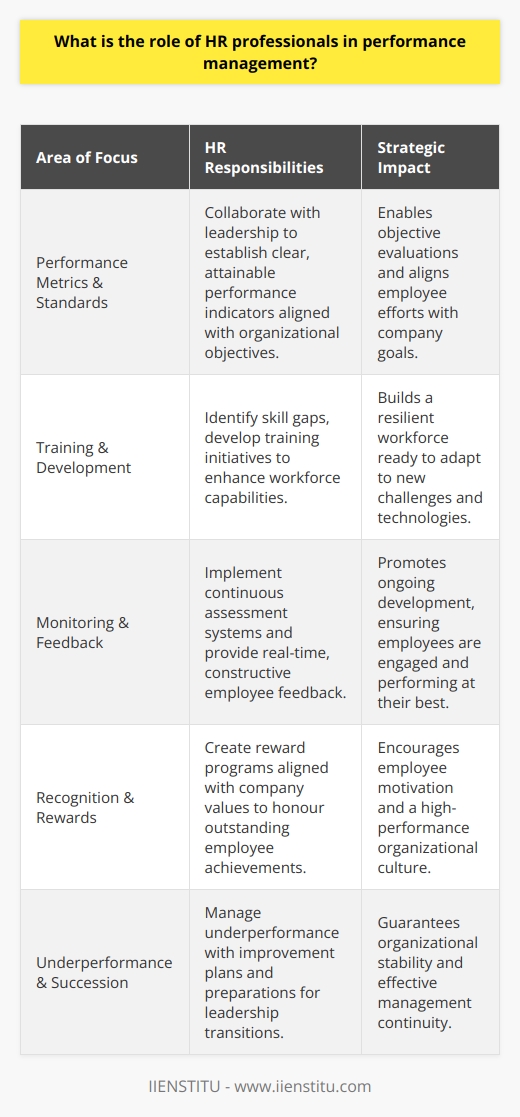
How does HR contribute to business success?
Role of HR in Business Strategy Execution
Human resource (HR) management plays an essential role in contributing to the success of a business through the implementation and execution of strategic initiatives. HR professionals ensure that the workforce is aligned with the organization's objectives, which in turn leads to improved performance and ultimately, business success.
Talent Acquisition and Retention
One of the primary responsibilities of HR is talent acquisition, which involves identifying, attracting, and retaining skilled and qualified employees. By selecting the right candidates, HR contributes to the organization's competitive advantage through a skilled workforce that drives innovation and productivity. Additionally, HR professionals develop and administer strategies for employee retention that encourage high-performance employees to remain with the company. This reduces turnover costs and ensures continuity in business operations.
Training and Development
HR professionals also contribute to business success through employee training and development, which enhances the skills and competencies of employees. By providing ongoing learning opportunities, HR ensures that the workforce remains up-to-date with current market trends and technological advancements. This equips employees with the necessary skills to adapt to the changing business environment, increasing the overall performance of the company.
Performance Management
Effective HR professionals understand that a comprehensive performance management system is crucial to business success. They develop and implement performance evaluation processes that identify the strengths and weaknesses of employees, providing feedback to improve their performance. This enables the organization to align individual performance with the company's objectives, ensuring that company goals are met.
Employee Engagement
Another critical aspect of HR's contribution to business success is fostering a positive work environment that promotes employee engagement. HR professionals create policies and programs that encourage collaboration, communication, and a sense of belonging amongst employees. Engaged employees are likely to be more motivated and committed to their work, leading to increased productivity and innovation.
Legal Compliance
Lastly, HR professionals are responsible for ensuring that the organization complies with all relevant employment and labor laws. This involves staying abreast of current regulations, developing policies and procedures to adhere to these laws, and preventing potential legal issues. Compliance with employment laws protects the organization from costly legal disputes and potential reputational damage, which can hinder business growth and success.
In conclusion, HR professionals play a vital role in contributing to business success by effectively managing the company's most valuable asset—its people. Through strategic talent acquisition, employee development, performance management, employee engagement, and legal compliance, HR significantly influences an organization's ability to achieve and maintain competitive advantage in the market.
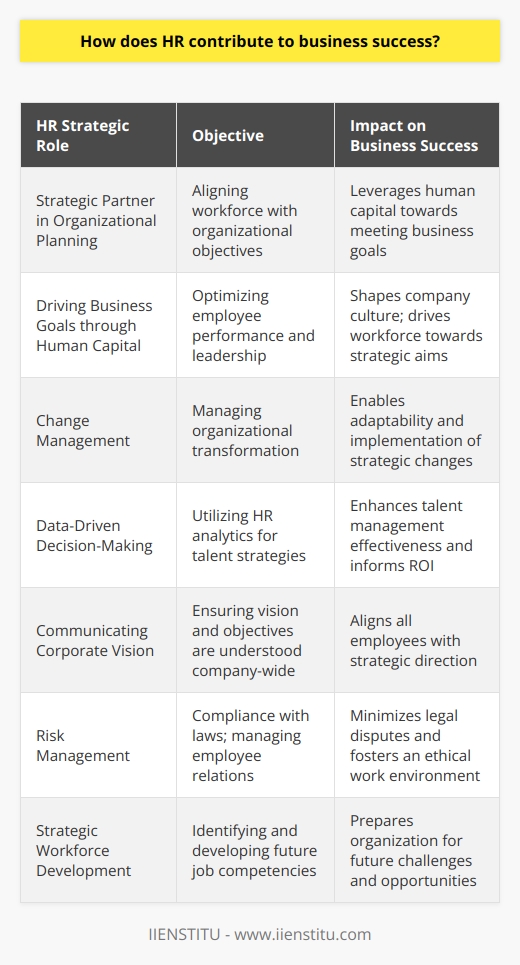
How has the role of HR management changed and evolved?
Transformation of Traditional Functions
The role of Human Resource (HR) management has significantly changed and evolved over the past few decades. Traditionally, HR departments focused on hiring, firing, and payroll management. However, the contemporary workplace landscape has created a paradigm shift in the responsibilities and expectations of HR management.
Influence of Technology
Technological advancements have played a pivotal role in transforming HR management functions. The automation of several HR tasks has streamlined processes such as recruitment, onboarding, and performance management. The utilization of technology has also enabled HR managers to use data-driven insights to inform strategic decisions.
Strategic HR Management
Modern HR management has adopted a strategic approach to managing human resources. This involves aligning HR policies with the organization's overarching goals to drive growth and success. HR managers are now tasked with designing initiatives to boost employee engagement, productivity, and skills development. As such, they play a critical role in facilitating organizational competitiveness and long-term growth.
Diversity and Inclusion
The increasing focus on diversity and inclusion in the workplace has necessitated HR managers to develop policies and practices that promote equal opportunities for employees. This involves creating a culture of respect and collaboration, ensuring that all employees feel valued and included.
Employee Well-being
One key aspect of the evolution of HR management is the growing importance placed on employee well-being and mental health. Modern HR departments actively promote work-life balance, offering resources to support employees' emotional and physical health. This is essential in sustaining employee motivation, engagement, and overall performance.
Legal and Ethical Compliance
The contemporary HR manager must be adept at navigating the complex legal and ethical landscape of the workplace. This includes ensuring that employment laws are adhered to, such as discrimination, harassment, and wage regulations. HR departments also play a crucial role in fostering an organizational culture of integrity, accountability, and ethical conduct.
In conclusion, the role of HR management has evolved from being transactional and administrative to strategic and integrative within organizations. It is now incumbent upon HR professionals to adapt to the new expectations and challenges associated with this transformative shift in human resource management.
